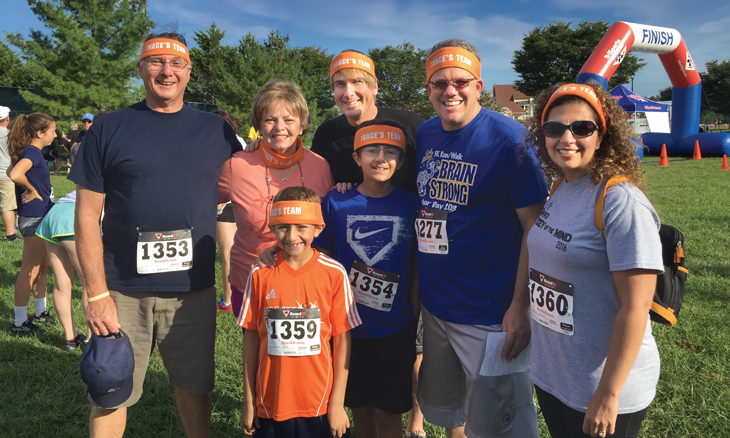
Banding Together for Trace
Twelve-year-old Trace Benton has been playing soccer since he was about four years old, has participated in baseball and some basketball, and recently took up tennis. Like most boys his age, Trace also enjoys video games. In the past several months, he started to learn guitar, which his father Benjhe Benton says he is “picking up quickly.” Trace is also proud of his “thick hair that clippers don’t really work on.”
Based on his interests and hobbies Trace sounds like a typical 12-year-old boy. In fact, looking at him and listening to him speak, you would think he’s not much different than other kids his age. But Trace has a unique characteristic that is rare among most 12-year-olds — or any age group, for that matter. In June 2016, Trace experienced a traumatic brain injury that almost took his life.
A scary start to summer camp
“It was the first day of summer, June 20, and he was at camp,” recalled his mother Arlene Benton. “We were playing soccer on the blacktop since the field is uneven,” said Trace as he began to tell his story about that fateful day. “It was one of the last rounds of ‘World Cup’ [a soccer competition he and his friends made up], and I was going after the ball when I tripped and fell and hit my head. My head really hurt, so they called my dad to come pick me up. It seemed to go on and on while I was waiting for him.”
Despite the fact there wasn’t any blood, a bump, or even redness on the front right side of Trace’s head from hitting the pavement, “when he started vomiting I knew something was really wrong,” recalled Benjhe. “So I took him to his pediatrician, Dr. Mahmoud. By the time we got there, he was losing all of his motor skills. Dr. Mahmoud said we needed to go get a CT scan right away. So I took him to the Radiology department at Kent General. The radiologist came out after looking at his scan and whispered into my ear that we needed to quickly get him to the ER.”
Upon arriving at the Emergency Department, Benjhe was told Trace required emergency surgery because the skull fracture he sustained during his fall had severed an artery, which triggered bleeding in his brain. Bayhealth Neurosurgeon James D. Mills, MD, performed the surgery almost immediately after Benjhe found out about the critical nature of Trace’s injury.
“Trace had what is called an epidural hematoma,” explained Dr. Mills. “Unless it is treated surgically within minutes, the likelihood of survival is very low.” As Arlene shared, it’s the same injury actress Natasha Richardson died from in 2009.
“Dr. Mills is a super-talented surgeon and a super-good guy,” said Benjhe. “Right before they took Trace in for surgery I said to him, ‘I put my faith in God a long time ago and I have to put my trust in you now — and I just met you.’ He hugged me and said, ‘I got this.’ That was so reassuring and unexpected.”
“Dr. Mahmoud also came to the hospital and scrubbed in and was there the whole time,” added Benjhe. “But, then again, he has been taking care of Trace since he was born,” explained Arlene.
“Since they were doing the surgery at Kent General, I assumed he would be staying there after,” Arlene continued. “But then they airlifted him to A.I. duPont. It was scary.”
Benjhe and Arlene had to drive up to Wilmington to meet Trace at A.I. duPont Hospital for Children, so one of the nurses on the medevac texted photos to them. “In one of the pictures, a nurse was praying over him,” Arlene recalled. “It was very comforting to us to receive those photos.”
“After looking at the CT scan, the staff at A.I. told us that, without a doubt, Dr. Mills and his team saved Trace’s life,” said Benjhe. Trace spent three days at A.I. duPont Hospital for Children. “The surgery part went by quickly — it seemed like five minutes — but the three days in the hospital felt like forever,” recalled Trace. “There were three things that helped me get through the three days in the hospital: my family, God, and having good communication with the people taking care of me.”
“It was a very emotional three days,” added Benjhe. “We went from nothing wrong, to everything wrong, to victory.”
Trace's Road to Recovery
When Trace got home from the hospital he “had to spend two weeks on the couch being completely quiet and in the dark. I wasn’t allowed any screen time [playing video games, watching TV, etc.],” he explained. “I eventually got my screen time back — first one minute, five minutes, 30 minutes, then one hour, and so on until I could do whatever.”
“I haven’t worn the shirt I was wearing that day,” he added. “It says ‘Time to Play Hard Ball’ on it.”
“When we took Trace back to camp, we told everyone he would have to wear a protective head band,” said Arlene. “They surprised us by making custom head bands with lettering that said ‘Trace’s Team’ and everyone wore them.”
“We didn’t find out until two weeks after the surgery that while the radiologist was telling me Trace needed to get to the ER, Dr. Mills was already on his way to the hospital and his team was assembling for the surgery,” said Benjhe.
The Bentons — who are longtime Bayhealth patients and have received several types of care — count Trace’s experience as the latest among many good ones they’ve had over the years. “It means so much to us what was done for Trace,” said Arlene. “We are very thankful to all of the doctors, nurses, etc., at Bayhealth, including Dr. Mahmoud,” added Benjhe. “It could not have been a better group of people, from A to Z.”
